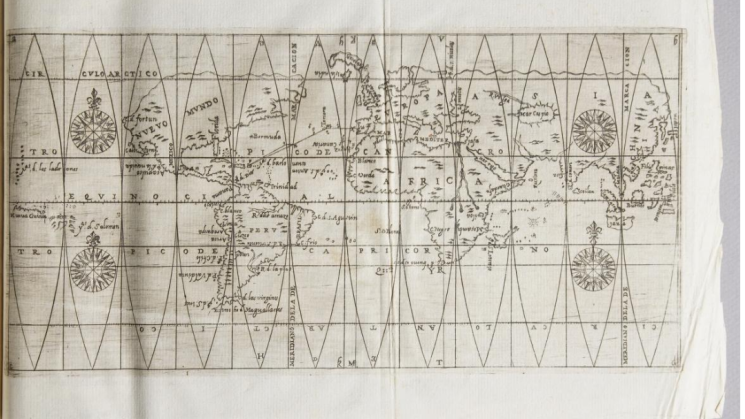A Triplet of Regimientos at the JCB

The book itself was remarkable. Written primarily for marine pilots, this Regimiento de navegación (Madrid, 1606) contained much more than rudimentary notions for navigation. The author, Andrés García de Céspedes, was a mathematician and engineer who had reached the highest positions in the maritime administration of the Spanish crown. Among other contributions, the book touches on the cartographic conflicts between Spain and Portugal –political and commercial conflicts in the end–, suggests improvements to navigational instruments, and describes the routes followed by Spanish fleets across the Atlantic and Pacific Oceans.
Maritime books held a prominent place in the private library of John Carter Brown. García de Céspedes's Regimiento de Navegación fit perfectly within the collector’s parameters, so he acquired it in the mid-nineteenth century.
The book, however, was imperfect, lacking the foldout world map included in the original edition. When the opportunity arose in 1945 to acquire a so-called perfect copy, the Library hastened to do so, as had been customary since the time when its founder sought to improve his collection by exchanging deficient volumes for flawless ones.
The copy with no map was sold, not an uncommon practice in libraries, which occasionally auction or exchange their duplicates. Of course, there is always the risk of disposing of a book that may be valuable or significant for some reason.
Recently, an antiquarian bookseller offered us another copy of García de Céspedes’s book, complete with the map, and featuring dozens of pages with marginal notes that piqued our curiosity. The anonymous reader expresses disagreements, sometimes with great emphasis, as when the name Copernicus is crossed out and substituted by el borracho, “the drunk” (García de Céspedes used Copernican astronomical tables to calculate the position of the North star).
With the bookseller’s consent, we photographed the annotated pages and sought the opinion of Thomas Haddad, historian of science and professor at the University of São Paulo, who was a long-term fellow at the JCB in 2020.
“There is no unequivocal evidence of who the annotator might have been, or when exactly they worked on this copy of the Regimiento,” Haddad wrote in an email. “I can state with confidence, though, that it must have been someone conversant in the technical aspects of late-sixteenth and early-seventeenth-century astral sciences.”
“I am convinced,” wrote Haddad, “that this particular reader’s main difference with García de Céspedes lies in the latter’s treatment of the effects of atmospheric refraction on the establishment of celestial coordinates from observations. Repeatedly, the annotator takes issue with the way celestial coordinates are corrected for refraction in the Regimiento. At times, the annotator’s impatience with what they perceive as García de Céspedes’s ignorance of optics transpire in a most humorous way: on page 114, for example, they point out that ‘If this author knew the proverb that says ne s(utor) ultra crepidam [something like "cobbler, keep to your last”] they wouldn’t speak such nonsense.’”
Traces that show the manner in which one of our books was read in its time –underlined, commented on, annotated, discussed, even refuted– are greatly valued by researchers. So, we proceeded to acquire the book.
During those months, we were in the process of looking back at the origins of the Library in 1846, a foundational year for our institution. Although John Carter Brown had a personal library –he started collecting books in his teenage years and inherited more from his family– in 1846 he received a shipment of books so remarkable that it would become a milestone in his collection.
The library preserves the invoice for that shipment, a document that includes letters from Christopher Columbus, Peter Martyr, and Hernán Cortés, books by Amerigo Vespucci, Gonzalo Fernández de Oviedo, and Bartolomé de las Casas, Pedro Nunes’s Tratado da Sphera, and Benedetto Bordone’s Isolario. That’s just to mention a few titles from the first page of the invoice, which consists of thirteen folios and comprises more than four hundred books.
The invoice shows that García de Céspedes’s Regimiento de Navegación had been part of that first shipment. It was in fact the imperfect copy that had been sold.
The stars aligned in our favor. While considering the acquisition of the annotated copy, the imperfect copy also appeared on the market. There it was, featured in the catalog of William S. Reese’s private collection, bound in red Morocco according to John Carter Brown’s tastes, with his initials stamped in gold leaf on the front cover.
That’s how the JCB obtained a triplet of Regimientos, each with its own story, all three fully digitized and available for consultation.
José Montelongo, Maury A. Bromsen Curator of Latin American Books